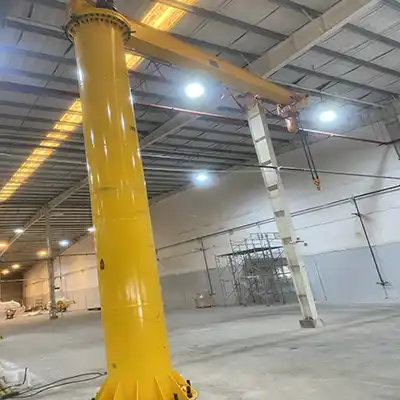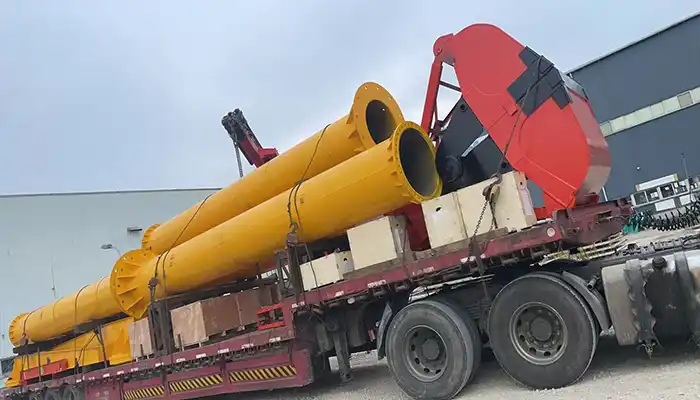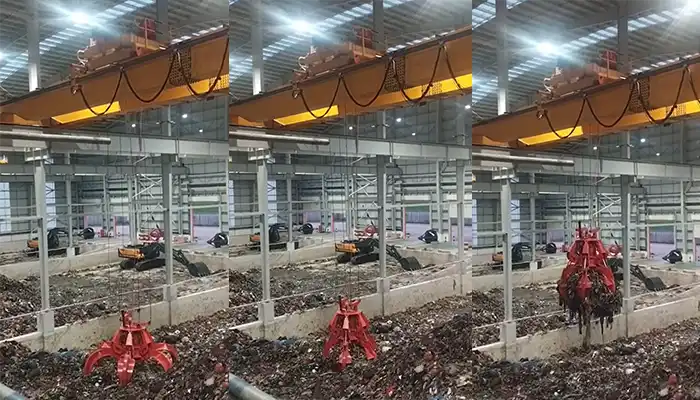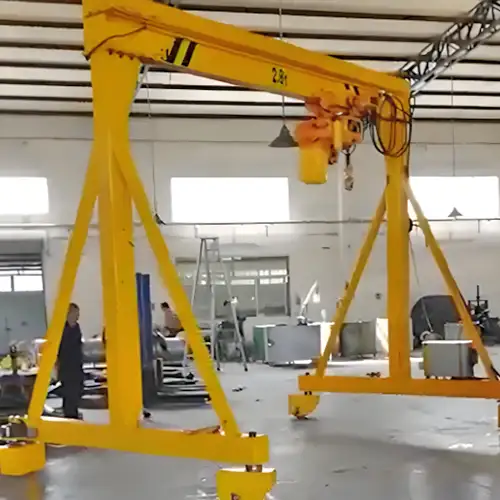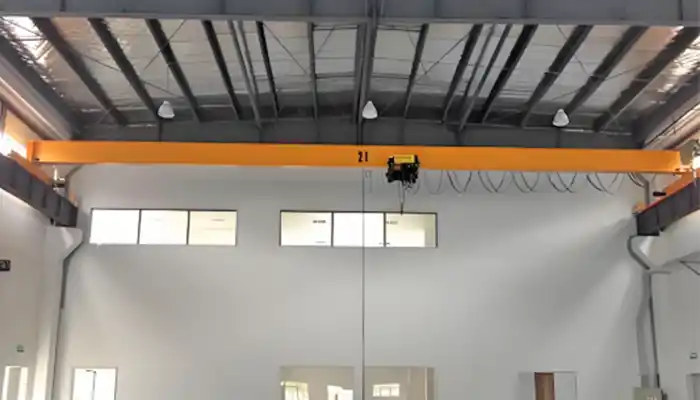
Is Bigger Always Better? Choose the Right Workshop Crane Tonnage
Discover how to select the ideal overhead crane capacity for your workshop—balancing performance, cost, space,&operational efficiency. Get right eot crane!
Bigger Isn't Always Better
Many workshop owners assume that a bigger crane means better performance. A high-capacity crane might seem like a safe choice, but it's not always the best fit. Overspending on unnecessary tonnage can lead to wasted space, higher costs, and operational inefficiencies.
Why Choosing the Right Tonnage Matters
Selecting the correct crane capacity is about efficiency, safety, and cost-effectiveness. The right crane should:
- Match your actual lifting needs – Too much capacity is overkill, too little is dangerous.
- Fit your workshop space – A larger crane may require more clearance or structural reinforcement.
- Operate efficiently – Higher tonnage means more power consumption, even when lifting light loads.
Making the right choice ensures smooth operations, avoids unnecessary expenses, and extends equipment lifespan.
Key Factors in the Decision
Choosing the right tonnage isn't just about guessing or playing it safe. It depends on several critical factors:
- Load requirements – What is the maximum and average weight you lift daily?
- Workshop size – How much space is available for installation and movement?
- Lifting height and span – Will the crane cover all work areas efficiently?
- Future needs – Are you planning to expand or increase your workload?
Understanding these points helps you invest wisely, ensuring that your crane works for you, not against you.
Why Crane Tonnage Matters
Picking the right crane tonnage isn't just about lifting heavy loads. It affects how smoothly your workshop runs, how safe your operations are, and how much you spend in the long run. If your crane is too big, you waste money and space. If it's too small, you risk overloading, frequent breakdowns, and safety issues.
How Crane Capacity Affects Your Workshop
A crane's tonnage should match your actual needs, not just what seems "safe" or "powerful." The right size crane:
- Handles your workload efficiently – It should lift the heaviest loads you deal with, but not much more.
- Fits within your space – A bigger crane requires more clearance and might not work well in a tight workshop.
- Operates safely – Overloading a small crane is dangerous, while controlling an oversized one can be tricky.
When the crane is properly sized, everything runs smoother, safer, and more cost-effectively.

double girder overhead bridge crane 3 ton to 350 ton
The Impact on Efficiency, Safety, and Cost
Choosing the wrong crane tonnage can create problems in three key areas:
- Efficiency – A crane that's too large may be overkill and harder to maneuver, while one that's too small slows down operations.
- Safety – An undersized crane can be overloaded, increasing the risk of accidents. An oversized one can make precise movements harder.
- Cost – A bigger crane means a bigger investment—not just in purchase price, but also in energy use, maintenance, and installation costs.
A poorly chosen crane can lead to higher expenses, unexpected downtime, or even workplace hazards.
What Happens If You Choose the Wrong Tonnage?
If the crane is too big:
- You pay more for equipment, energy, and maintenance than necessary.
- It takes up more space, possibly causing layout issues in your workshop.
- It may not handle small, precise lifts as effectively.
If the crane is too small:
- Overloading becomes a serious risk, leading to breakdowns and safety hazards.
- The crane wears out faster, requiring more repairs and replacements.
- You may face delays when lifting heavier loads, slowing down operations.
Choosing the right tonnage isn't just about getting the job done—it's about working smarter, safer, and more efficiently.
The Risks of Oversized Cranes
Many buyers assume that a bigger crane is always a better investment. But in reality, going too big can lead to unnecessary costs and operational challenges. A crane should be sized to fit your actual workload, not just chosen based on the idea that "more is better."
Higher Initial Costs and Unnecessary Investment
Buying a crane with more tonnage than you need means paying more upfront for equipment that won't be fully utilized.
- Larger cranes require heavier-duty components, which increase the purchase price.
- Extra capacity often goes unused, making the investment inefficient.
- More complex installation may require additional structural reinforcements.
Instead of spending more on capacity you don't need, it's smarter to invest in a crane that matches your real requirements.
Increased Power Consumption and Operational Costs
Bigger cranes don't just cost more to buy—they cost more to run, too.
- Higher energy consumption means bigger electricity bills, even for light loads.
- Stronger motors and mechanical parts lead to increased maintenance costs.
- More frequent inspections and servicing may be required due to the crane's size and complexity.
An oversized crane might look impressive, but it can drain your budget over time.
Space Limitations and Installation Challenges
A large crane needs a large space. If your workshop isn't designed for it, you could run into serious problems.
- Limited ceiling height can restrict movement or require costly structural modifications.
- Wider spans and bigger support structures take up valuable working space.
- Difficult installation may require reinforcement of floors or columns.
Instead of forcing a large crane into your workshop, it's better to choose one that fits comfortably within your space.
Difficulties in Precise Material Handling for Lighter Loads
A crane designed for heavy lifting may not perform well when handling smaller loads.
- Large, high-capacity hoists may lack the precision needed for delicate movements.
- Increased inertia makes stopping and adjusting load positions harder.
- More strain on workshop workflow if workers struggle to control the crane efficiently.
For workshops that frequently handle smaller loads, a more balanced crane capacity allows for smoother, more precise operations.
Bigger doesn't always mean better. A properly sized crane keeps costs low, operations efficient, and handling precise. Instead of focusing on maximum tonnage, consider what will truly benefit your workshop in the long run.
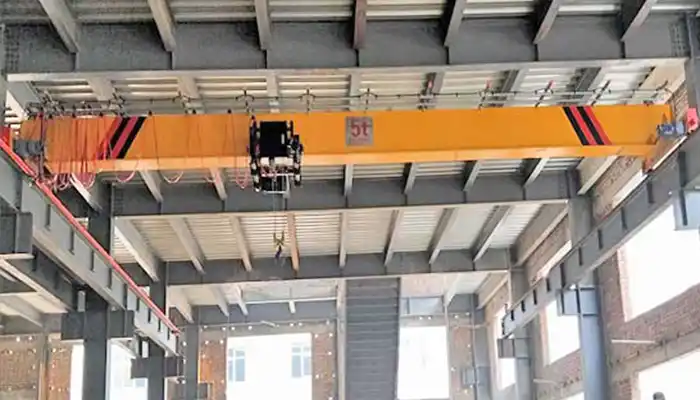
top running single girder overhead bridge crane 1 ton to 20 ton
The Dangers of Undersized Cranes
Choosing a crane that's too small for your workload can create serious risks and long-term issues. While it might seem like a cost-effective solution at first, an undersized crane often leads to safety concerns, higher maintenance costs, and operational inefficiencies.
Overloading Risks and Safety Concerns
An undersized crane is more likely to face overloading, which can lead to serious accidents.
- Overloading puts excessive strain on the crane's components, increasing the risk of failure.
- Safety hazards like falling loads or equipment malfunctions become more likely.
- Compliance issues may arise if your crane cannot safely handle the required loads, leading to legal and insurance complications.
Operating a crane beyond its capacity can result in costly accidents and injuries, making safety a top priority in choosing the right tonnage.
Faster Wear and Tear, Leading to Higher Maintenance Costs
When you push a crane beyond its designed capacity, the wear and tear happens much faster.
- Stress on motors, gears, and hoists increases, causing components to degrade more quickly.
- More frequent repairs are needed to keep the crane running safely and effectively.
- Higher maintenance costs can quickly add up as parts need to be replaced or repaired more often.
A crane that's undersized for its job may require constant attention, leading to higher maintenance bills over time.
Operational Inefficiencies and Workflow Disruptions
Undersized cranes can seriously slow down your workshop operations.
- Slower lifting times when the crane struggles to handle loads efficiently.
- Frequent downtime as the crane is overloaded or needs repair.
- Workflow interruptions as workers wait for the crane to handle loads or perform lifts in smaller increments.
Instead of speeding up operations, an undersized crane can hold you back by causing delays and disruptions.
While an undersized crane may seem like a quick way to save money, the long-term risks of overloading, maintenance issues, and inefficiency can outweigh the initial savings. Investing in the right crane capacity ensures that your workshop runs smoothly, safely, and cost-effectively.

underhung bridge crane 1 ton to 10 ton
Key Factors in Choosing the Right Crane Tonnage
Choosing the right crane tonnage isn't just about picking a number off the shelf. It's a decision that needs to be based on your specific workshop needs. Several key factors come into play when determining the ideal crane capacity. Let's break them down:
Load Weight and Frequency
The first and most important consideration is the maximum and average load weights the crane will be handling.
- Max load weight – Understand the heaviest load your crane will lift regularly, and make sure the crane can handle it comfortably.
- Average load weight – Don't just look at maximum capacity; assess the typical load your crane will lift most often.
If your crane is underpowered for the loads you lift, it could risk overloading. Conversely, if it's too powerful for most tasks, you're wasting energy and money.
Workshop Size and Layout
Your workshop's physical layout and available space have a huge influence on the crane tonnage you choose.
- Space constraints – Ensure that the crane fits within the available space without crowding the workshop. Oversized cranes can limit movement and cause interference with other equipment.
- Structural considerations – Larger cranes may need more robust foundations or ceiling reinforcements. Make sure your facility can accommodate the crane's size and weight.
A crane that doesn't fit your space can cause more problems than it solves, so size and layout should be factored into the decision.
Lifting Height and Span
Consider the height and span that your crane needs to cover to serve your workshop effectively.
- Lifting height – The crane must be able to lift loads to the necessary height for your operations. If you regularly need to lift items to high shelves or platforms, ensure the crane has sufficient height.
- Span – This is the distance the crane can travel. Be sure it covers the necessary area without leaving parts of your workshop inaccessible.
Choosing the right lifting height and span ensures that your crane can handle all the tasks you require without limitation.
Future Expansion Plans
It's easy to buy a crane for your current needs, but what about the future?
- Anticipate future growth – Think about how your needs may evolve in the coming years. Will you increase production? Add new machines?
- Avoid overspending – While it's important to plan for growth, buying an oversized crane can lead to unnecessary costs. Aim for a crane that can grow with your business without overpaying for features you don't yet need.
Investing in a crane that can be adapted to future demands without major upgrades is a smart move.
Industry and Application-Specific Needs
Different industries have specific requirements for cranes, so tailor your choice based on your work type.
- Steel mills – Cranes used in steel mills need to handle heavy, high-temperature materials, which often require specialized features.
- Fabrication shops – Cranes in fabrication shops may need to handle a range of loads with precise control.
- Other industries – Whether you're in construction, automotive, or manufacturing, the crane's tonnage should match the specific demands of your industry.
Choosing the right crane tonnage involves much more than just picking the largest available option. It's about considering your load, space, height, future plans, and industry-specific needs to find the best fit. By evaluating these factors carefully, you'll ensure that your crane is perfectly suited for your workshop's operations.
VI. Customization Options for the Best Fit
When selecting the right crane for your workshop, customization is key. Every workshop is unique, and sometimes off-the-shelf solutions don't cut it. By considering options like crane design, tonnage, and alternative lifting solutions, you can ensure a perfect fit for your needs.
Single Girder vs. Double Girder Cranes for Different Capacities
The design of the crane can play a huge role in its performance, especially for workshops with specific lifting needs.
- Single Girder Cranes – These are more compact and cost-effective, ideal for lighter loads and smaller spaces. They typically handle loads up to 20-25 tons.
- Double Girder Cranes – These cranes are stronger and more rigid, capable of handling heavier loads and higher capacities (often above 25 tons). They also offer greater lifting height and span, making them suitable for large workshops or heavy-duty applications.
Your choice depends on the weight and size of the loads you handle. For lighter loads and tight spaces, a single girder crane may be sufficient, while double girder cranes are better for heavier, more demanding tasks.
Choosing Between Standard and Customized Tonnage Solutions
While standard tonnage options can work for many workshops, customization may be necessary for specific needs.
Standard tonnage solutions – These are ideal for workshops with consistent and predictable load requirements. They're typically cost-effective and quick to implement.
Customized tonnage solutions – If your workload varies or includes unique materials, a customized crane might be the better choice. This allows for specific adjustments, such as:
- Higher lifting capacity for more demanding loads.
- Tailored dimensions to fit in tight spaces.
- Adjustable hoisting speeds for more precision.
A customized crane ensures that your equipment will match your exact operational needs and provide better long-term value.
Alternative Lifting Solutions for Unique Workshop Requirements
Not every workshop is suited to a standard overhead crane. For certain applications, alternative lifting solutions may be the way to go.
- Jib Cranes – These are useful for lifting loads in specific areas of a workshop, offering flexibility and reducing the need for large overhead systems.
- Monorail Systems – If you need to move materials along a fixed path, a monorail crane system can be a great option.
- Hoists with Trolleys – For smaller, lighter loads that don't require an entire overhead system, hoists with trolleys can be a more economical choice.
Exploring these alternatives can help you create a more specialized, efficient workspace tailored to your specific needs, all while saving on space and cost.
Customization options can significantly improve crane performance and efficiency in your workshop. Whether you're choosing between a single or double girder crane, deciding on standard or customized tonnage, or looking for alternative lifting solutions, there are plenty of options to consider. By making these informed decisions, you can ensure that your crane is the best fit for your operations.
Conclusion
Choosing the right crane tonnage is critical for ensuring your workshop operates efficiently, safely, and cost-effectively. Right-sizing your crane means balancing lifting capacity with your actual needs, avoiding both the dangers of overloading and the wasted costs of an oversized crane.
When you invest in the right crane, you not only improve your workflow but also save money on energy, maintenance, and unnecessary upgrades. It's essential to evaluate all the factors—such as load weight, workshop space, and future growth—before making your final decision.
Before you make a purchase, take the time to carefully assess your specific needs. If you're unsure, don't hesitate to reach out for professional consultation. Experts can help guide you to the best crane solution tailored to your unique workshop requirements, ensuring you make a smart and informed choice.
